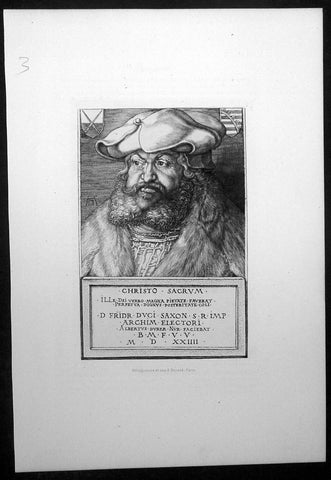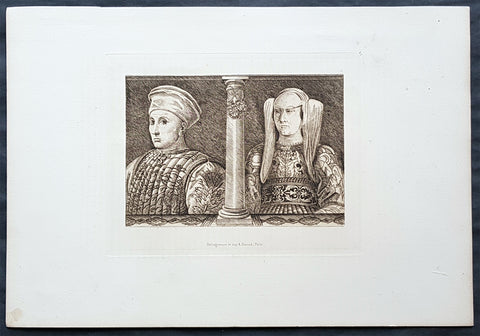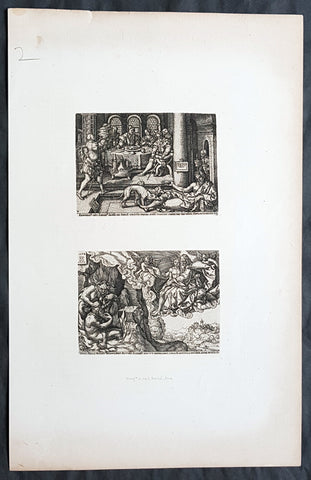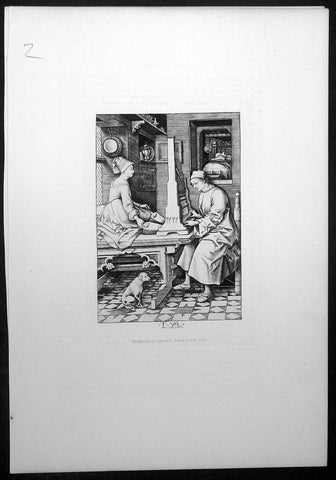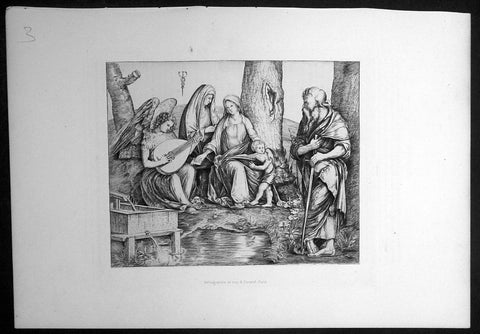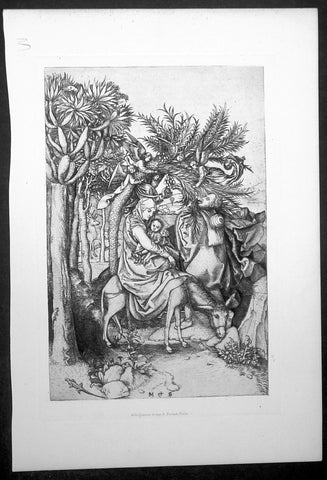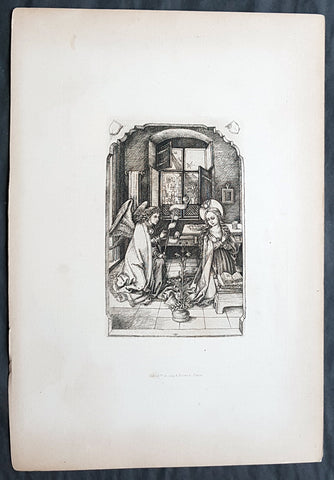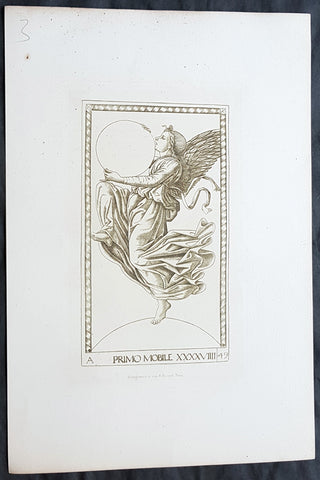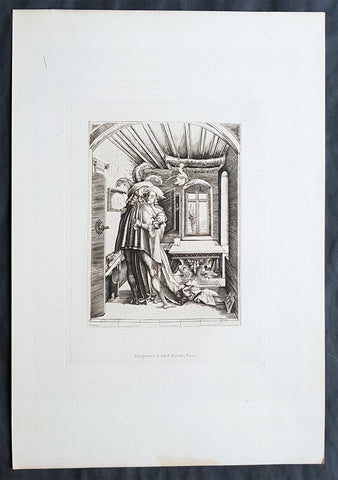
Charles Amand Durand (1837-1917)
Charles Amand Durand (1837-1917) was a French engraver who was highly skilled in the art of engraving and recognized for his ability to reproduce the fine details and nuances of works by master artists such as Rembrandt, Dürer, and others.
Durand was a master engraver who specialized in the techniques of intaglio engraving, a form of printmaking in which lines are incised into a metal plate using sharp tools. He was known for his meticulous attention to detail and his ability to reproduce the tonal variations and textures of the original artwork.
Durand's reputation as an engraver led to many commissions to create new plates based on old masterpieces that had been damaged or lost. He worked closely with museums, collectors, and art historians to ensure that his engravings were faithful to the original works, and he used his extensive knowledge of engraving techniques to produce plates that were highly detailed and precise.
Durand also produced his own engravings, which were highly regarded and exhibited at the Paris Salon. His work was characterized by its technical precision and its ability to capture the subtle nuances of light and shadow.
In addition to his work as an engraver, Durand was also an important teacher of engraving at the École des Beaux-Arts in Paris, where he trained many of the leading engravers of the late 19th and early 20th centuries. His influence on the art of engraving can still be seen today, and his work continues to be highly collectible and admired by art lovers and collectors around the world.
Charles Amand Durand (11)
1870 Amand-Durand after Albrecht Durer Antique Print - Frederick III of Saxony
- Title : Christo Sacrum.....Fridr Dvci Saxon....Albertus Durer....MDXXIIII
- Size: 13 1/2in x 9 1/2in (345mm x 240mm)
- Condition: (A+) Fine Condition
- Date : 1870
- Ref #: 22401
Description:
This fine, original antique wood-cut print of the protector of Martin Luther, Frederick the Wise of Saxony, by the famous German engraver Albrecht Dürer in 1496 was faithfully re-engraved and published by Charles Amand-Durand in 1870.
These beautiful re-engravings of classic and historical wood-cuts were painstakingly re-issued by Amand-Durand in Paris in the mid to late 19th century. Such is the quality of his re-strikes that Durands prints are now in major institutional collections such a the Louvre, National Gallery, The Met and many other famous Galleries. Please see below for further background on Amand-Durand.
General Definitions:
Paper thickness and quality: - Heavy and stable
Paper color : - off white
Age of map color: -
Colors used: -
General color appearance: -
Paper size: - 14in x 9 1/2in (350mm x 240mm)
Plate size: - 8in x 6in (205mm x 1530mm)
Margins: - Min 1in (25mm)
Imperfections:
Margins: - None
Plate area: - None
Verso: - None
Background:
Albrecht Dürer 1471 – 1528 was a painter, printmaker, and theorist of the German Renaissance. Born in Nuremberg, Dürer established his reputation and influence across Europe when he was still in his twenties due to his high-quality woodcut prints. He was in communication with the major Italian artists of his time, including Raphael, Giovanni Bellini and Leonardo da Vinci, and from 1512 he was patronized by emperor Maximilian I. Dürer is commemorated by both the Lutheran and Episcopal Churches.
Dürer\'s vast body of work includes engravings, his preferred technique in his later prints, altarpieces, portraits and self-portraits, watercolours and books. The woodcuts, such as the Apocalypse series (1498), are more Gothic than the rest of his work. His well-known engravings include the Knight, Death, and the Devil (1513), Saint Jerome in his Study (1514) and Melencolia I (1514), which has been the subject of extensive analysis and interpretation. His watercolours also mark him as one of the first European landscape artists, while his ambitious woodcuts revolutionized the potential of that medium.
Dürer\'s introduction of classical motifs into Northern art, through his knowledge of Italian artists and German humanists, has secured his reputation as one of the most important figures of the Northern Renaissance. This is reinforced by his theoretical treatises, which involve principles of mathematics, perspective, and ideal proportions.
The Portrait of Frederick III of Saxony is a tempera on canvas painting by German Renaissance artist Albrecht Dürer, executed in 1496. It is housed in the Gemäldegalerie of Berlin, Germany.
The painting was one of the first commissions received from Frederick III, Elector of Saxony, together with the Seven Sorrows Polyptych and the central panel of the Dresden Altarpiece. Dürer knew the elector during the latter\'s short stay in Nuremberg in April 1496.
The German artist portrayed the Elector again in a burin etching in 1524.
Dürer portrayed Fredericks bust from three-quarters, looking right, above a dark green background. Elements such as the parapet on which his arms lie, or the hands holding a roll, were typical of Flemish art of the period.
Frederick\'s impervious personality, as well as his status, are emphasized by the large beret and by his determined glance.
Frederick III 1463 – 1525, also known as Frederick the Wise (German Friedrich der Weise) was Elector of Saxony from 1486 to 1525, who is mostly remembered for the worldly protection of his subject Martin Luther.
1870 Amand-Durand after Baccio Baldini Antique Print Ludovico Gonzaga III & Wife
- Title : Ludovico Gonzaga III and his Wife
- Date : 1870
- Condition: (A+) Fine Condition
- Ref: 22042
- Size: 13 1/2in x 9 1/2in (345mm x 240mm)
Description:
This fine, original antique Heliograph of Ludovico Gonzaga III and his Wife, Barbara of Brandenburg, by the Italian engraver Andrea Mantegna in the 15th century was re-engraved and published by Charles Amand-Durand in 1870.
These faithful re-engravings of classic and historical wood-cuts were faithfully re-issued by Amand-Durand in Paris in the mid to late 19th century. Such is the quality of his re-strikes that Durands prints are now in major institutional collections such a the Louvre, National Gallery, The Met and many other famous Galleries. Please see below for further background on Amand-Durand.
General Definitions:
Paper thickness and quality: - Heavy and stable
Paper color : - off white
Age of map color: -
Colors used: -
General color appearance: -
Paper size: - 13 1/2in x 9 1/2in (345mm x 240mm)
Plate size: - 8in x 6in (205mm x 1530mm)
Margins: - Min 1in (25mm)
Imperfections:
Margins: - None
Plate area: - None
Verso: - None
Background:
Andrea Mantegna 1431 – 1506 was an Italian painter, a student of Roman archeology, and son-in-law of Jacopo Bellini. Like other artists of the time, Mantegna experimented with perspective, e.g. by lowering the horizon in order to create a sense of greater monumentality. His flinty, metallic landscapes and somewhat stony figures give evidence of a fundamentally sculptural approach to painting. He also led a workshop that was the leading producer of prints in Venice before 1500.
Mantegna was no less eminent as an engraver, though his history in that respect is somewhat obscure, partly because he never signed or dated any of his plates, but for a single disputed instance of 1472. The account which has come down to us from Vasari (as usual keen to assert that everything flows from Florence) is that Mantegna began engraving in Rome, prompted by the engravings produced by the Florentine Baccio Baldini after Sandro Botticelli. This is now considered most unlikely as it would consign all the numerous and elaborate engravings made by Mantegna to the last sixteen or seventeen years of his life, which seems a scanty space for them, and besides the earlier engravings indicate an earlier period of his artistic style. He may have begun engraving while still in Padua, under the tuition of a distinguished goldsmith, Niccolò. He and his workshop engraved about thirty plates, according to the usual reckoning; large, full of figures, and highly studied. It is now considered either that he only engraved seven himself, or none. Another artist from the workshop who made several plates is usually identified as Giovanni Antonio da Brescia (aka Zoan Andrea).
Among the principal examples are: Battle of the Sea Monsters, Virgin and Child, a Bacchanal Festival, Hercules and Antaeus, Marine Gods, Judith with the Head of Holophernes, the Deposition from the Cross, the Entombment, the Resurrection, the Man of Sorrows, the Virgin in a Grotto, and several scenes from the Triumph of Julius Caesar after his paintings. Several of his engravings are supposed to be executed on some metal less hard than copper. The technique of himself and his followers is characterized by the strongly marked forms of the design, and by the parallel hatch marks to produce shadows. The closer the parallel marks, the darker the blacks were. The prints are frequently to be found in two states, or editions. In the first state the prints have been taken off with the roller, or even by handpressing, and they are weak in tint; in the second state the printing press has been used, and the ink is stronger.
Neither Mantegna or his workshop are now believed to have produced the so-called Mantegna Tarocchi cards.
Ludovico III Gonzaga of Mantua, also spelled Lodovico 1412 – 1478 was the ruler of the Italian city of Mantua from 1444 to his death in 1478.
Ludovico was the son of Gianfrancesco I Gonzaga and Paola Malatesta.
Ludovico followed the path of his father, Gianfrancesco, fighting as a condottiero from as early as 1432, when Gianfrancesco was vice-commander of Francesco Bussone\'s army. In 1433, he married Barbara of Brandenburg, niece of emperor Sigismund.
Starting from 1436 (perhaps without the approval of his father) he entered the service of the Visconti of the Duchy of Milan. The result was that Gianfrancesco exiled Ludovico from Mantua, together with his wife, naming Carlo Gonzaga as heir. However, in 1438 Gianfrancesco himself was hired by the Visconti, and reconciled with Ludovico in 1441. Ludovico succeeded to the marquisate of Mantua in 1444, although part of the family fiefs went to his brothers Carlo, Gianlucido and Alessandro. At the time, the Mantuan state was reduced in size and in poor conditions after years of war and large expenses.
From 1445 to 1450 Ludovico served as condottiero for Milan, Florence, Venice and Naples, switching his allegiance in order to grant the higher level of peace for his lands. In 1448 he took part in the battle of Caravaggio, and was forced to flee. In 1449 he entered the service of Venice in the league formed with Florence against Milan. In 1450 he received permission to lead an army for King Alfonso of Naples in Lombardy, with the intent of gaining some possessions for himself. However, Francesco Sforza, the new duke of Milan, enticed him with the promise of Lonato, Peschiera and Asola, formerly Mantuan territories but then part of Venice. Venice responded by sacking Castiglione delle Stiviere (1452) and hiring Ludovico\'s brother, Carlo.
On 14 June 1453 Ludovico routed the troops of Carlo at Goito, but Venetian troops under Niccolò Piccinino thwarted any attempt to regain Asola. The Peace of Lodi (1454) obliged Ludovico to give back all his conquests, and to renounce definitively his claim to the three cities. However, he obtained his brother\'s land after Carlos childless death in 1456.
The moment of highest prestige for Mantua was the Council, held in the city from 27 May 1459 to 19 January 1460, summoned by Pope Pius II to launch a crusade against the Ottoman Turks, who had conquered Constantinople some years earlier. However, the pope was not satisfied with the host city, writing: The place was marshy and unhealthy, and the heat burnt up everything; the wine was unpalatable and the food unpleasant. However, the council ended on a note of great personal prestige for Ludovico with the elevation of his son Francesco to the purple.
From 1466 Ludovico was more or less constantly at the service of the Sforza of Milan. He died in Goito in 1478, during a plague. He was buried in Mantua cathedral
1870 Amand-Durand after Heinrich Aldegrever Antique Print - Parable of Lararus
- Title : Erumnos hic lazar iages ad ianva divitis/Dives epvlo elamis
- Date : 1870
- Condition: (A+) Fine Condition
- Ref: 22444
- Size: 13 1/2in x 9 1/2in (345mm x 240mm)
Description:
This fine, original antique Heliograph two panels of the parable of The Rich Man and Lazarus or Dives and Lazarus or Lazarus and Dives by the German engraver Heinrich Aldegrever or Aldegraf in the early 16th century was re-engraved and published by Charles Amand-Durand in 1870.
These faithful re-engravings of classic and historical wood-cuts were faithfully re-issued by Amand-Durand in Paris in the mid to late 19th century. Such is the quality of his re-strikes that Durands prints are now in major institutional collections such a the Louvre, National Gallery, The Met and many other famous Galleries. Please see below for further background on Amand-Durand.
General Definitions:
Paper thickness and quality: - Heavy and stable
Paper color : - off white
Age of map color: -
Colors used: -
General color appearance: -
Paper size: - 13 1/2in x 9 1/2in (345mm x 240mm)
Plate size: - 8in x 6in (205mm x 1530mm)
Margins: - Min 1in (25mm)
Imperfections:
Margins: - None
Plate area: - None
Verso: - None
Background:
Heinrich Aldegrever or Aldegraf (1502–1561) was a German painter and engraver. He was one of the Little Masters, the group of German artists making small old master prints in the generation after Dürer.
Painter, printmaker and goldsmith active in a Westphalia milieu. Born in Paderborn. His real name was Trippenmecker, which in Westphalian dialect means a clog-maker. It is not known where Aldegrever was taught. He probably worked in a workshop of one of the Soest goldsmiths. His early works show a strong Westphalian influence. Aldegrever made a journey to the Netherlands, where he became acquainted with works of Joos van Cleve, Barendt van Orley, Lucas van Leyden and Jacob Cornelisz.
Around 1525 he moved to Soest, where a year later he painted the wings and predella of the Mary altar for the church of St. Peter. His signature and symbolic clog show that he was still using his fathers name.
His first engravings appeared in 1527. They were signed with a monogram AG, resembling closely that of Albrecht Dürer. In 1531, influenced by surrounding religious fervour, he became a Lutheran. Because of lack of church commissions he devoted most of his time to portrait painting and printmaking. Aldegrevers some 290 engravings and woodcuts, chiefly from his own designs, are delicate and minute, though somewhat hard in style, and entitle him to a place in the front rank of the so-called Little Masters: Barthel Beham, his brother Hans Sebald Beham, and Georg Pencz, with whom he is often compared. Like them, he was also a skilled ornament designer. From the close resemblance of his style to that of Albrecht Dürer he has also sometimes been called the Albert of Westphalia.
About a third of his prints were ornamental engravings; they were used as models by artists and craftsmen well into the seventeenth century.
Aldegrever, who actively supported the Reformation, executed portraits of Martin Luther and Philip Melanchthon. Although he chose the Lutheran Church, he had friends among the Anabaptists. He was commissioned by the bishop of Münster in 1535–36 to engrave portraits of Anabaptist leaders Jan van Leyden and Bernhard Knipperdolling, although they were already imprisoned, and only caricatures of them circulated. In the cycle Power of Death, done under visible influence of Hans Holbein, he criticizes the vices of the Catholic Church.
Aldegrever was interested also in folk subjects. In 1538 and 1551 two series of prints depicting marriage dances were made. An important part of his oeuvre are prints on mythological subjects, the Deeds of Hercules being one of the best examples.
Only two paintings are firmly attributed to him: the wings and predella of the Marienaltar (c. 1525-6) in the Wiesenkirche in Soest, and a portrait of Graf Phillip von Waldeck (1837) in Schloss Aroldsen
The parable of the rich man and Lazarus(also called the Dives and Lazarus or Lazarus and Dives) is a well-known parable of Jesus appearing in the Gospel of Luke.
The Gospel of Luke (Luke 16:19–31) tells of the relationship, during life and after death, between an unnamed rich man and a poor beggar named Lazarus. The traditional name Dives is not actually a name, but instead a word for rich man, dives in the text of the Latin Bible, the Vulgate. The rich man was also given the names Neuēs (i.e. Nineveh) and Fineas (i.e. Phineas) in the 3rd and 4th centuries.
Along with the parables of the Ten Virgins, Prodigal Son, and Good Samaritan, it was one of the most frequently illustrated parables in medieval art, perhaps because of its vivid account of an afterlife.
1870 Amand-Durand after Israhel van Meckenem Antique Print - Organ Player & Wife
- Title : The Organ player and his Wife
- Size: 13 1/2in x 9 1/2in (345mm x 240mm)
- Condition: (A+) Fine Condition
- Date : 1870
- Ref #: 22404
Description:
This fine, original antique wood-cut print of The Organ player and wife by Israhel van Meckenem in late 15th century was faithfully re-engraved and published by Charles Amand-Durand in 1870.
These beautiful re-engravings of classic and historical wood-cuts were painstakingly re-issued by Amand-Durand in Paris in the mid to late 19th century. Such is the quality of his re-strikes that Durands prints are now in major institutional collections such a the Louvre, National Gallery, The Met and many other famous Galleries. Please see below for further background on Amand-Durand.
General Definitions:
Paper thickness and quality: - Heavy and stable
Paper color : - off white
Age of map color: -
Colors used: -
General color appearance: -
Paper size: - 14in x 9 1/2in (350mm x 240mm)
Plate size: - 8in x 6in (205mm x 1530mm)
Margins: - Min 1in (25mm)
Imperfections:
Margins: - None
Plate area: - None
Verso: - None
Background:
This husband-and-wife duo performs an intimate domestic concert, jointly playing a diminutive pipe organ with four stops. The wife operates the two bellows in time to the music, giving voice to the notes, while her husband creates the melody on the keyboard. He is clad in a housecoat and comfortable slippers and she wears a cozy fur-trimmed dress. Shown at the same scale and working in tandem, they symbolize a harmonious marriage. The little dog listening attentively is both an emblem of loyalty and a realistic detail of their well-to-do home.
Israhel van Meckenem (c.1445 – 10 November 1503), also known as Israhel van Meckenem the Younger, was a German printmaker and goldsmith, perhaps of a Dutch family origin.
He was the most prolific engraver of the fifteenth century and an important figure in the early history of old master prints. He was active from 1465 until his death.
He probably trained with Master E. S. in South Germany, and may well have been with him at his death c. 1467, since he acquired and reworked forty-one of the master\'s plates. Another two hundred of van Meckenem\'s own prints also were copies of ones by Master E. S. In total, he produced over six hundred plates, most of which were copies of other prints; they represent about 20% of print production by all Northern European artists in the period of his working life. His career lasted long enough for him to copy Dürer prints.
He copied prints by the Housebook Master, including some now otherwise lost, Martin Schongauer, and many other German engravers. His famous and very fine late series on the Life of the Virgin appears to have been based on drawings by Hans Holbein the Elder or his workshop, and he may have entered into a regular commercial relationship with Holbein.
His early works were fairly crude, but in the 1480s he developed an effective personal style and made increasingly large and finished works. His own compositions are often very lively, and take a great interest in the secular life of his day. One famous print, supposed to illustrate the story of St John the Baptist and Salome, pushes the specific incidents of the story far in the background to allow space for a scene of court dancers, dressed in the height of contemporary fashion, which takes up most of the plate.
He was sophisticated in self-presentation, signing later prints with his name and town, and producing the first self-portrait print of himself and his wife, which was also the first portrait print of an identifiable person. Some plates seem to have been reworked more than once by his workshop, or produced in more than one version, and many impressions have survived, so his ability to distribute and sell his prints was evidently equally well developed. He was apparently the first to issue engraved (as opposed to woodcut) indulgences, apparently bootlegged version[s] ... never subject to papal review; one print promises 20,000 years reduction of time in Purgatory per set of prayers, increased in a second state to 45,000 years.
In the Heures de Charles d\'Angoulême, an important manuscript showing the links between printmaking and illumination in the late 15th century, Robinet Testard incorporated sixteen of van Meckenem\'s prints, gluing them directly on to the vellum then overpainting.
1870 Amand-Durand after Jacapo de Barbari Antique Print Holy Family w/ St Paul
- Title : Holy Family with St. Anne, St. Paul and Lute-Playing Angel
- Size: 13 1/2in x 9 1/2in (345mm x 240mm)
- Condition: (A+) Fine Condition
- Date : 1870
- Ref #: 22408
Description:
This fine, original antique wood-cut print of Holy Family with St Paul by Jacapo de Barbari in the early 16th century was faithfully re-engraved and published by Charles Amand-Durand in 1870.
These beautiful re-engravings of classic and historical wood-cuts were painstakingly re-issued by Amand-Durand in Paris in the mid to late 19th century. Such is the quality of his re-strikes that Durands prints are now in major institutional collections such a the Louvre, National Gallery, The Met and many other famous Galleries. Please see below for further background on Amand-Durand.
General Definitions:
Paper thickness and quality: - Heavy and stable
Paper color : - off white
Age of map color: -
Colors used: -
General color appearance: -
Paper size: - 14in x 9 1/2in (350mm x 240mm)
Plate size: - 8in x 6in (205mm x 1530mm)
Margins: - Min 1in (25mm)
Imperfections:
Margins: - None
Plate area: - None
Verso: - None
Background:
Jacopo de Barbari sometimes known or referred to as de Barbari, de Barberi, de Barbari, Barbaro, Barberino, Barbarigo or Barberigo (1460/70 – 1516), was an Italian painter and print-maker with a highly individual style. He moved from Venice to Germany in 1500, thus becoming the first Italian Renaissance artist of stature to work in Northern Europe. His few surviving paintings (about twelve) include the first known example of trompe l oeil since antiquity. His twenty-nine engravings and three very large woodcuts were also highly influential.
His earliest documented work is his huge (1.345 x 2.818 metres, from six blocks) and impressive woodcut aerial view Map of Venice, for which a privilege was granted to its publisher in 1500, recording that the work had taken three years. This clearly drew on the work of many surveyors, but was a spectacular feat nonetheless, and caused a considerable stir from the first. It was later updated by others to reflect major new building projects in a second state of the print.
Apart from the Map of Venice, he produced two other woodcuts, both of men and satyrs, which were the largest and most impressive figurative woodcuts yet produced, and which established the Italian tradition of fine, large, woodcuts for the following decades. These may have also been produced before 1500; they are clearly strongly influenced by Mantegna.
By the time the Map of Venice was published de\' Barbari had already left for Germany, where he met Dürer, who he may have already known from Dürer\'s first Italian trip (a passage in a letter of Dürer\'s is ambiguous). They discussed human proportion, not obviously one of de\' Barbari\'s strengths, but Dürer was evidently fascinated by what he had to say, though he recorded that de\' Barberi had not told him everything he knew:
...I find no one who has written anything about how to make canon of human proportions except for a man named Jacob, born in Venice and a charming painter. He showed me a man and a woman which he had made according to measure, so that I would now rather see what he meant than behold a new kingdom... Jacobus did not want to show his principles to me clearly, that I saw well. (From an unpublished draft of the Introduction to Dürer\'s own book on human proportions)
Twenty years later Dürer tried unsuccessfully to get the Archduchess Margaret, Habsburg Regent of the Netherlands, to give him a manuscript book she had on the subject by de Barbari, by then dead; the book has not survived.
His style is related to his possible master, Alvise Vivarini and to Giovanni Bellini, but has a languorous quality all its own. Apart from Dürer, the influence of Mantegna\'s technique also appears in what are probably the earlier engravings, done around the turn of the century, with parallel hatching. His engravings are mostly small, showing just a few figures. Truculent satyrs feature in several prints; there are a number of mythological subjects, including two Sacrifices to Priapus.
The earlier prints show figures with small heads and somewhat shapeless bodies, with sloping shoulders and thick torsos supported by slender legs — also seen in his paintings. Probably from a middle period come several nudes, the most famous being Apollo and Diana, St Sebastian and the Three Bound Captives. In these his ability to organise the whole composition has greatly improved.
In a final group, the style becomes more Italianate, and the compositions more complex. These have an enigmatic, haunting atmosphere, and a very refined technique. Levenson has proposed that they date from his period in the Netherlands and were influenced by the young Lucas van Leyden.
1870 Amand-Durand after Marcantonio Raimondi Antique Print Writer Pietro Aretino
- Title : Petrus Arretinus Acerrimus Virtutum Ac Vitiorum Demostrator
- Size: 13 1/2in x 9 1/2in (345mm x 240mm)
- Condition: (A+) Fine Condition
- Date : 1870
- Ref #: 22442
Description:
This fine, original antique wood-cut print of the Italian playwright and poet Pietro Aretino by Marcantonio Raimondi in the early 16th century was faithfully re-engraved and published by Charles Amand-Durand in 1870.
These beautiful re-engravings of classic and historical wood-cuts were painstakingly re-issued by Amand-Durand in Paris in the mid to late 19th century. Such is the quality of his re-strikes that Durands prints are now in major institutional collections such a the Louvre, National Gallery, The Met and many other famous Galleries. Please see below for further background on Amand-Durand.
General Definitions:
Paper thickness and quality: - Heavy and stable
Paper color : - off white
Age of map color: -
Colors used: -
General color appearance: -
Paper size: - 14in x 9 1/2in (350mm x 240mm)
Plate size: - 8in x 6in (205mm x 1530mm)
Margins: - Min 1in (25mm)
Imperfections:
Margins: - None
Plate area: - None
Verso: - None
Background:
Marcantonio Raimondi, often called simply Marcantonio 1470-1482 was an Italian engraver, known for being the first important print-maker whose body of work consists largely of prints copying paintings. He is therefore a key figure in the rise of the reproductive print. He also systematized a technique of engraving that became dominant in Italy and elsewhere. His collaboration with Raphael greatly helped his career, and he continued to exploit Raphael\'s works after the painter\'s death in 1520, playing a large part in spreading High Renaissance styles across Europe. Much of the biographical information we have comes from his life, the only one of a printmaker, in Vasaris Lives of the Artists.
About this time he began to make copies of Dürers woodcut series, the Life of the Virgin. This was extremely common practice, although normally engravers copied other expensive engravings rather than the cheaper woodcuts. However Dürers woodcuts had raised the standard of the medium considerably, and since Marcantonio continued to copy a large number of both Dürers engravings and woodcuts, he must have found it profitable.
His early copies included Dürers famous AD monogram, and Dürer made a complaint to the Venetian Government, which won him some legal protection for his monogram, but not his compositions, in Venetian territory - an important case in the slowly evolving history of intellectual property law.
Marcantonio appears to have spent some of the last half of the decade in Venice, but no dates are known.
The Massacre of the Innocents, designed by Raphael to be engraved.
He is attributed with around 300 engravings. After years of great success, his career ran into trouble in the mid-1520s; he was imprisoned for a time in Rome over his role in the series of erotic prints I Modi, and then, according to Vasari, lost all his money in the Sack of Rome in 1527, after which none of his work can be securely dated.
Pietro Aretino 1492 – 1556 was an Italian author, playwright, poet, satirist and blackmailer, who wielded influence on contemporary art and politics and developed modern literary pornography.
1870 Amand-Durand after Martin Schongauer Antique Print - Flight into Egypt
- Title : The Flight into Egypt
- Size: 13 1/2in x 9 1/2in (345mm x 240mm)
- Condition: (A+) Fine Condition
- Date : 1870
- Ref #: 22406
Description:
This fine, original antique wood-cut print an illustrating of the Flight out of Israel into Egypt by The Holy Family by Martin Schongauer - signed M†S - in 15th century was faithfully re-engraved and published by Charles Amand-Durand in 1870.
These beautiful re-engravings of classic and historical wood-cuts were painstakingly re-issued by Amand-Durand in Paris in the mid to late 19th century. Such is the quality of his re-strikes that Durands prints are now in major institutional collections such a the Louvre, National Gallery, The Met and many other famous Galleries. Please see below for further background on Amand-Durand.
General Definitions:
Paper thickness and quality: - Heavy and stable
Paper color : - off white
Age of map color: -
Colors used: -
General color appearance: -
Paper size: - 14in x 9 1/2in (350mm x 240mm)
Plate size: - 8in x 6in (205mm x 1530mm)
Margins: - Min 1in (25mm)
Imperfections:
Margins: - None
Plate area: - None
Verso: - None
Background:
Martin Schongauer 1445 - 1491 was one of the most prolific early engravers from the Rhine Valley. He signed all his prints with his initials, making him the first printmaker whose authorship was absolutely clear. While a handful of the artist’s paintings survive, Schongauer’s engravings inspired generations of artists, including Albrecht Dürer. This iconic image shows the Holy Family resting while fleeing the Massacre of the Innocents and their home in Israel for Egypt. The work reflects some traditional accounts of the story, in which angels lowered date palms for easy harvesting, so Mary, Joseph, and the Christ Child would not starve.
Schongauer was the most important printmaker north of the Alps before Albrecht Dürer.
The main work of Schongauer\'s life was the production of a large number of beautiful engravings, which were largely sold, not only in Germany, but also in Italy and even in England and Spain. Vasari says that Michelangelo copied one of his engravings, in the Trial of Saint Anthony. His style shows no trace of Italian influence, but a very clear and organised Gothic.
His subjects are mainly religious, but include comic scenes of ordinary life such as the Peasant family going to market or the Two apprentices fighting. One hundred and sixteen engravings are generally recognised as by his hand, and since several are only known from a single impression, there were probably others that are now lost. Many of his pupils\' plates as well as his own are signed, M†S, as are many copies probably by artists with no connection to him.
Among the most renowned of Schongauer\'s engravings are the series of the Passion and the Death and Coronation of the Virgin, and the series of the Wise and Foolish Virgins. All are remarkable for their miniature-like treatment, their brilliant touch, and their chromatic force. Some, such as the Death of the Virgin and the Adoration of the Magi are richly-filled compositions of many figures, treated with much largeness of style in spite of their minute scale.
He established the system of depicting volume by means of cross-hatching (lines in two directions) which was further developed by Dürer, and was the first engraver to curve parallel lines, probably by rotating the plate against a steady burin. He also developed a burin technique producing deeper lines on the plate, which meant that more impressions could be taken before the plate became worn.
According to Arthur Mayger Hind, Schongauer was one of the first German engravers to rise above the Gothic limitations both of setting and type and that he actualises an idea of beauty which in its nearer approach to more absolute ideals appeals to a far more universal appreciation than earlier engravers such as Master E. S.
The British Museum and other major print rooms possess fine collections of Schongauer\'s prints.
1870 Amand-Durand after Van Leyden Antique Print St George rescuing the Princess
- Title : Heliogravure et imp. A. Durand_Paris
- Size: 13 1/2in x 9 1/2in (345mm x 240mm)
- Condition: (A+) Fine Condition
- Date : 1870
- Ref #: 22443
Description:
This fine, original antique Heliograph of St. George Liberating the Princess by Lucas Van Leyden (1494 - 1533) in 1508 was re-engraved and published by Charles Amand-Durand in 1870.
These faithful re-engravings of classic and historical wood-cuts were faithfully re-issued by Amand-Durand in Paris in the mid to late 19th century. Such is the quality of his re-strikes that Durands prints are now in major institutional collections such a the Louvre, National Gallery, The Met and many other famous Galleries. Please see below for further background on Amand-Durand.
General Definitions:
Paper thickness and quality: - Heavy and stable
Paper color : - off white
Age of map color: -
Colors used: -
General color appearance: -
Paper size: - 13 1/2in x 9 1/2in (345mm x 240mm)
Plate size: - 8in x 6in (205mm x 1530mm)
Margins: - Min 1in (25mm)
Imperfections:
Margins: - None
Plate area: - None
Verso: - None
Background:
Lucas van Leyden (1494 – 1533), also named either Lucas Hugensz or Lucas Jacobsz, was a Dutch engraver and painter. He was among the first Dutch exponents of genre painting and is generally regarded as a very accomplished engraver.
Lucas was the son of Huygh Jacobsz. and was mainly active in Leiden.
Carel van Mander characterizes Lucas as a tireless artist, who as a child annoyed his mother by working long hours after nightfall, which she forbid not only for the cost of candlelight, but also because she felt that too much study was bad for his sensibilities. According to Van Mander, as a boy he only consorted with other young artists, such as painters, glass-etchers and goldsmiths, and was paid by the Heer van Lochorst (Johan van Lockhorst of Leiden, who died in 1510) a golden florin for each of his years at age 12 for a watercolor of St. Hubert.
From 1513 to 1517, Lucas created a series of woodcuts called The Power of Women which consisted of two large and small sets of prints. The series is one of a number of representations of the Power of Women theme, which was extremely popular in Renaissance art and literature. Artworks in the genre depict the traditional roles of men and women in inverse, with women dominating over men in various situations. The subjects illustrated often consist of legendary historical women who were considered to be virtuous heroines as well as women who were considered cunning, seductive, and manipulative of men. The purpose of the Power of Women theme was to demonstrate that even the strongest and wisest of men were not resistant to the sexuality of women.
The legend of Saint George and the Dragon describes the saint taming and slaying a dragon that demanded human sacrifices; the saint thereby rescues the princess chosen as the next offering.
1870 Amand-Durand after Van Leyden Antique Print The Annunciation to Virgin Mary
- Title : Heliogravure et imp A. Durand...Paris
- Date : 1870
- Condition: (A+) Fine Condition
- Ref: 22445
- Size: 14in x 9 1/2in (350mm x 240mm)
Description:
This fine, original antique Heliograph of The Annunciation, the Virgin Mary visited by the Angel Gabriel by Lucas Van Leyden (1494 - 1533) in 1508 was re-engraved and published by Charles Amand-Durand in 1870.
These faithful re-engravings of classic and historical wood-cuts were faithfully re-issued by Amand-Durand in Paris in the mid to late 19th century. Such is the quality of his re-strikes that Durands prints are now in major institutional collections such a the Louvre, National Gallery, The Met and many other famous Galleries. Please see below for further background on Amand-Durand.
General Definitions:
Paper thickness and quality: - Heavy and stable
Paper color : - off white
Age of map color: -
Colors used: -
General color appearance: -
Paper size: - 13 1/2in x 9 1/2in (345mm x 240mm)
Plate size: - 8in x 6in (205mm x 1530mm)
Margins: - Min 1in (25mm)
Imperfections:
Margins: - None
Plate area: - None
Verso: - None
Lucas van Leyden (1494 – 1533), also named either Lucas Hugensz or Lucas Jacobsz, was a Dutch engraver and painter. He was among the first Dutch exponents of genre painting and is generally regarded as a very accomplished engraver.
Lucas was the son of Huygh Jacobsz. and was mainly active in Leiden.
Carel van Mander characterizes Lucas as a tireless artist, who as a child annoyed his mother by working long hours after nightfall, which she forbid not only for the cost of candlelight, but also because she felt that too much study was bad for his sensibilities. According to Van Mander, as a boy he only consorted with other young artists, such as painters, glass-etchers and goldsmiths, and was paid by the Heer van Lochorst (Johan van Lockhorst of Leiden, who died in 1510) a golden florin for each of his years at age 12 for a watercolor of St. Hubert.
From 1513 to 1517, Lucas created a series of woodcuts called The Power of Women which consisted of two large and small sets of prints. The series is one of a number of representations of the Power of Women theme, which was extremely popular in Renaissance art and literature. Artworks in the genre depict the traditional roles of men and women in inverse, with women dominating over men in various situations. The subjects illustrated often consist of legendary historical women who were considered to be virtuous heroines as well as women who were considered cunning, seductive, and manipulative of men. The purpose of the Power of Women theme was to demonstrate that even the strongest and wisest of men were not resistant to the sexuality of women.
The Annunciation (from Latin annuntiatio), also referred to as The Annunciation to the Blessed Virgin Mary, the Annunciation of Our Lady, or the Annunciation of the Lord, is the Christian celebration of the announcement by the angel Gabriel to the Virgin Mary that she would conceive and become the mother of Jesus, the Son of God, marking his Incarnation. Gabriel told Mary to name her son Yeshua, meaning YHWH is salvation.
According to Luke 1:26, the Annunciation occurred in the sixth month of Elizabeth\'s pregnancy with John the Baptist. Many Christians observe this event with the Feast of the Annunciation on 25 March, an approximation of the northern vernal equinox nine full months before Christmas, the ceremonial birthday of Jesus. The Annunciation is a key topic in Christian art in general, as well as in Marian art in the Catholic Church, particularly during the Middle Ages and Renaissance. A work of art depicting the Annunciation is sometimes itself called an Annunciation.
1870 Charles Amand-Durand after Johann Ladenspelder Antique Print #49 Tarot Card
- Title : Primo Mobile XXXXVIIII
- Date : 1870
- Condition: (A+) Fine Condition
- Ref: 22400
- Size: 13 1/2in x 9 1/2in (345mm x 240mm)
Description:
This fine, original antique Heliograph of card #49 of the Mantegna Tarocchi or Tarot Cards by the German engraver Johann Ladenspelder in the mid 16th century was re-engraved and published by Charles Amand-Durand in 1870.
These faithful re-engravings of classic and historical wood-cuts were faithfully re-issued by Amand-Durand in Paris in the mid to late 19th century. Such is the quality of his re-strikes that Durands prints are now in major institutional collections such a the Louvre, National Gallery, The Met and many other famous Galleries. Please see below for further background on Amand-Durand.
General Definitions:
Paper thickness and quality: - Heavy and stable
Paper color : - off white
Age of map color: -
Colors used: -
General color appearance: -
Paper size: - 13 1/2in x 9 1/2in (345mm x 240mm)
Plate size: - 8in x 6in (205mm x 1530mm)
Margins: - Min 1in (25mm)
Imperfections:
Margins: - None
Plate area: - None
Verso: - None
Background:
Johann (Hans) Ladenspelder 1512 - 1574 (aka Hans of Essen) was a german printmaker and engraver. He is particularly known for engraving a copy of a complete set (E series) of Mantegna Tarocchi cards, one of the earliest complete sets still extant.
1870 Charles Amand-Durand after Mattaus Zaisinger Antique Print - The Embrace
- Title : The Embrace
- Date : 1870
- Condition: (A+) Fine Condition
- Ref: 22403-1
- Size: 13 1/2in x 9 1/2in (345mm x 240mm)
Description:
This fine, original antique Heliograph of The Embrace by Master M Z or Mattaus Zaisinger in 1503 was re-engraved and published by Charles Amand-Durand in 1870.
These faithful re-engravings of classic and historical wood-cuts were faithfully re-issued by Amand-Durand in Paris in the mid to late 19th century. Such is the quality of his re-strikes that Durands prints are now in major institutional collections such a the Louvre, National Gallery, The Met and many other famous Galleries. Please see below for further background on Amand-Durand.
General Definitions:
Paper thickness and quality: - Heavy and stable
Paper color : - off white
Age of map color: -
Colors used: -
General color appearance: -
Paper size: - 13 1/2in x 9 1/2in (345mm x 240mm)
Plate size: - 8in x 6in (205mm x 1530mm)
Margins: - Min 1in (25mm)
Imperfections:
Margins: - None
Plate area: - None
Verso: - None
Matthaus Zaisinger (aka Master M.Z.), German (1498 - 1555) was a German Goldsmith & Engraver who published twenty-two engravings with the signature initials MZ. Six are dated (1500, 1501, 1503). There are no later dated prints and it is believed that most of his work is concentrated around c1500. The prints are equally divided between religious and secular subjects, often a state of disquiet inhabits his figures, accompanied by eccentric use of perspective and abrupt changes in scale, as seen for example in The Embrace and Solomons Idolatry. Most of his works have landscape backgrounds executed with a delicate, atmospheric touch that suggests a precursor of Albrecht Altdorfer and other painters of the Danube school.
<b>The Embrace</b> contains all of the elements of an adulterous tryst with the stag horns on the chandelier being a common symbol of cuckoldry, but the woman seems an unenthusiastic participant.

